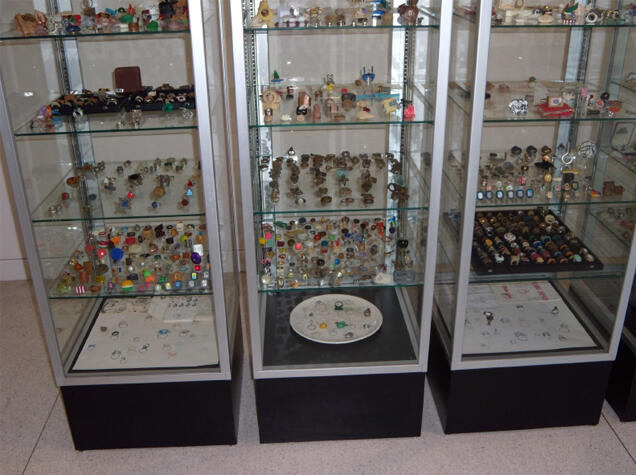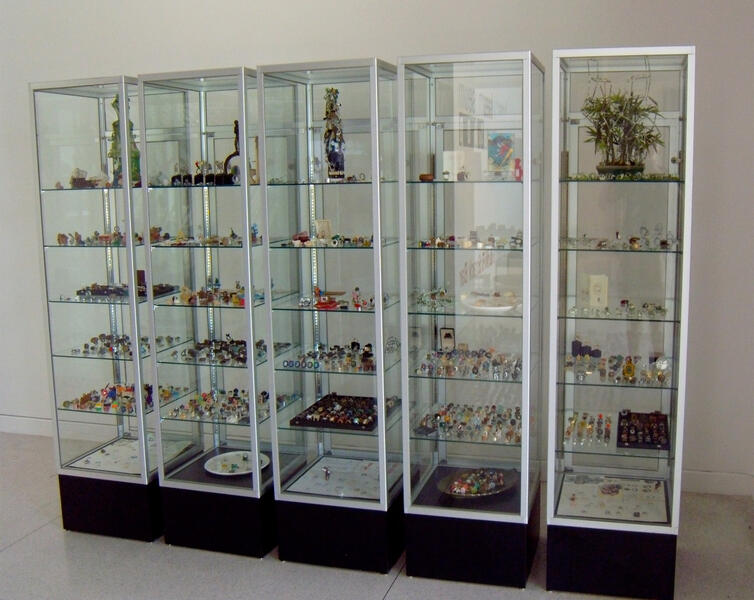César Trasobares: A Lecture About His Installation of Rings in Human Rites at Bass Museum
In 1983, Cesar Trasobares began the construction of RINGHEAD (Exorcism from Style), a work still in progress in 1983 that now is installed at the entrance of the collective exhibition Human Rites. Curated by Silvia Karman Cubiñá, Bass Museum of Art Executive Director and Chief Curator, and Steve Holmes, Adjunct Curator, Bass Museum of Art.

On September 18, Trasobares will give a lecture about his installation that also includes an open documentary project of people talking about their rings. The installation presents rings made by Trasobares accompanied by finger rings from his collection. While the rings conceived and made by Trasobares in Miami and New York span a period of almost three decades, the other rings hark back to antiquity and to places like Rome, Africa, Uzbekistan, China and India, most crafted by unknown artists and artisans. The collection also includes a selection of rings acquired in various cities throughout the Unites States reflecting numerous threads of popular culture and evolving traditions of political activism, social pride and personal adornment.
As the Miami Herald states: “Some of his rings function as a homage to artists he liked or worked with, from Claes Oldenburg to Purvis Young; other pieces, such as a kitschy quince ring and rings made from dollar bills, expand on his previous museum shows. The found-object rings -- biker rings with skulls, a huge affair used for Jewish Orthodox weddings, Miccosukee rings that resemble alligators --offer a telling glimpse at varying cultures”.
The variety of styles, materials and contents in the group of rings documents a fertile archetypal tradition of universal creativity and suggests the rich and complex vastness of human customs and rituals associated with these objects. The artist’s practice and focus is highlighted through a selection of drawings, books and texts accompanying his physical rings.
Anyone may participate in this video-history by taping their testimonial in the station situated in the adjacent room. Others may submit their stories as specified in the project notes. The artist not only invites everybody to explore and ponder this powerful cultural object, but also will give a speech about the conception and the process of creation of this open artwork.
The public is invited to realize different actions, such as: remember rings, draw rings, design rings, give rings, observe power & influence rings, imagine future rings, dream about unknown rings, or just stop crying about lost rings.
Human Rites examines ritual through art; and it also examines art through ritual, depending on your point of view. From mundane human activities to sacred practices, from the past through the present, rites and rituals have been pervasive subjects in artistic practice. It also, present works such as 15th century devotional polychrome statues of Mary, and 16th century altarpieces alongside works by renowned contemporary artists. This juxtaposition of works circumscribes the timelessness of rituals, expressed historically and anthropologically in religious, as well as other contexts. Works of art in this exhibition also reflect both the subconscious and premeditated human need for rituals in our every day lives. Votive works by Marina Abramović and Shirin Neshat survey the ceremonial aspects of womanhood; Rirkrit Tiravanija’s Buddha figurines describe the devotional offerings that people manufacture for their gods; collected items by artists Mark Dion, John Beech and the same César Trasobares investigate form, the found object and performative aspects; Allan McCollum 's repetitive series reflect the construction of objects as substitutes for the real object. Ai Wei Wei uses the bicycle as both symbol and found object in the construction of a monumental totem form.
Additional artists in the exhibition include: El Anatsui, Bernd and Hilla Becher, Christian Boltanski, Sophie Calle, Paolo Canevari, Emilio Chapela, Anna Chu, Subodh Gupta, Thomas Hirshhorn, Rafael Lozano-Hemmer, Kelly Mark, Roberto Marossi, Priscilla Monge, Jonathan Monk, Massimo Vitali, Erwin Wurm, and selections from the Collection of the Bass Museum or Art. This exhibition is the second of three exhibitions in The Endless Renaissance series, at the Bass Museum. It began with the exhibition The Endless Renaissance in 2009, and will conclude with a publication in 2012. Unique ring made by Cesar Trasobares for the Bass Museum of Art in 2010 RINGHEAD (Exorcisim from style)








